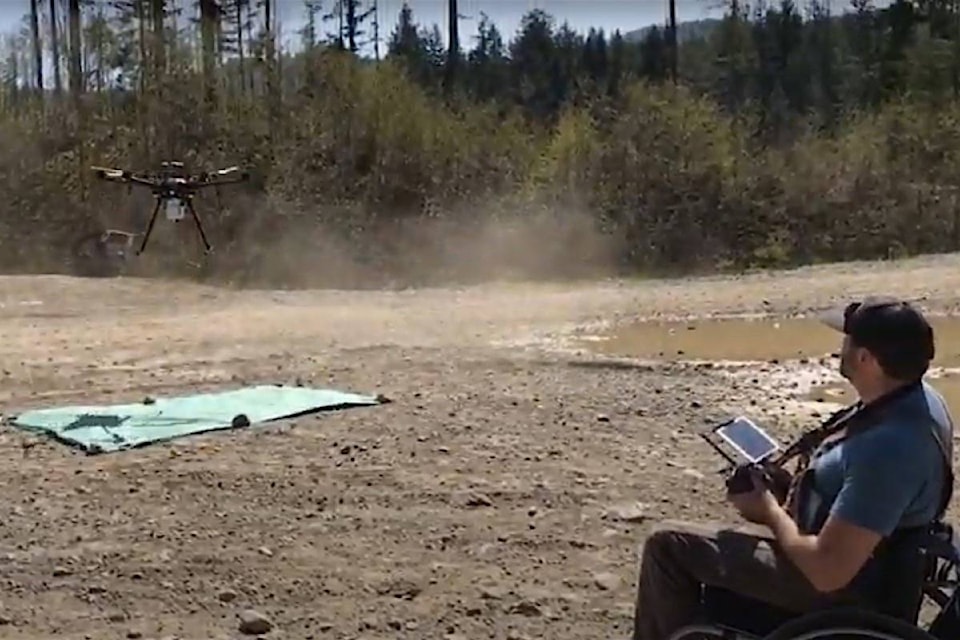B.C.91¬„¡ƒ ”∆µôs forest industry has been buoyed by high construction demand and prices during the COVID-19 recession, and public health restrictions have pushed the industry into new areas of innovation.
91¬„¡ƒ ”∆µúRemote sensing91¬„¡ƒ ”∆µù is a term familiar to the mining industry, where has a long-standing program to scan vast areas from aircraft to look for magnetic signatures of mineral deposits. At this week91¬„¡ƒ ”∆µôs virtual B.C. Natural Resources Forum, participants heard about the growth of virtual forestry using drones.
Mike Wilcox, president of a Vancouver startup called FYBR Inc., told a forest industry panel about the growth of his company that accelerated as pandemic restrictions forced new ways of doing business.
91¬„¡ƒ ”∆µúWe bought our first drone, we set up our office at the entrepreneurship building at UBC, and we started cold-calling,91¬„¡ƒ ”∆µù Wilcox told the forum in a video conference Jan. 27. 91¬„¡ƒ ”∆µúWe started cold-calling mines, bulk terminals oil and gas companies and forest companies.91¬„¡ƒ ”∆µù
91¬„¡ƒ ”∆µúWe saw older, experienced foresters using this information to share wisdom with younger, tech-savvy foresters who were keen to take on the role of drone pilots"
91¬„¡ƒ ”∆µî Tom Fletcher (@tomfletcherbc)
- FYBR Inc. president Mike Wilcox
Growing up in Kamloops in the heart of the B.C. Interior led him to focus on forest industry to find specialized solutions.
91¬„¡ƒ ”∆µúWe collaborated with the integrated remote sensing lab at UBC to start to answer some questions such as, can we use drones to assess forest inventory throughout the harvest cycle?91¬„¡ƒ ”∆µù Wilcox said.91¬„¡ƒ ”∆µúCan we identify early infestation or burn severity? Can we accurately measure wood inventory at pulp mills, sawmills and pellet plants?91¬„¡ƒ ”∆µù
Travelling to B.C.91¬„¡ƒ ”∆µôs forest industry competitors in Scandinavia and the southeastern U.S. showed the need for B.C. to innovate or fall behind. FYBR Inc. is currently managing inventory for 50 mills in North America, and processing thousands of hectares of forest imagery each month. And with travel and in-person meetings restricted, the technology found new uses like meeting governments91¬„¡ƒ ”∆µô increasing demand for environmental reporting.
91¬„¡ƒ ”∆µúDigitizing the forest or mill and bringing it to a virtual boardroom has been incredibly powerful, especially during this pandemic when we can91¬„¡ƒ ”∆µôt all physically be in the same room,91¬„¡ƒ ”∆µù he said. 91¬„¡ƒ ”∆µúWe saw older, experienced foresters using this information to share wisdom with younger, tech-savvy foresters who were keen to take on the role of drone pilots. We saw industry working with government to adopt a new technology and a new process to improve fibre utilization and reporting.91¬„¡ƒ ”∆µù
RELATED:
RELATED:
For the B.C. government, maintaining inventory of the vast Crown lands of B.C.91¬„¡ƒ ”∆µôs Interior and Coast has long been a challenge. The forests ministry needs to not only monitor harvest licences and watershed protection, but measure the extent of forest fire damage to replant forests.
At a separate panel with B.C. cabinet ministers Jan. 28, Forests Minister Katrine Conroy said B.C. planted a record 300 million trees in 2020. 91¬„¡ƒ ”∆µúThey did it without a single COVID outbreak in any of their camps, which is pretty incredible,91¬„¡ƒ ”∆µù Conroy said.
The federal government has made a further commitment to tree planting, although there hasn91¬„¡ƒ ”∆µôt been a federal budget in more than a year to dedicate funds to a plan that also extends to urban areas.
A Seattle company called DroneSeed is using large drones to drop what it calls 91¬„¡ƒ ”∆µúseed vessels91¬„¡ƒ ”∆µù on burned areas of forest, but it isn91¬„¡ƒ ”∆µôt as good as boots on the ground setting seedlings by hand.
tfletcher@blackpress.ca
Like us on and follow us on .



